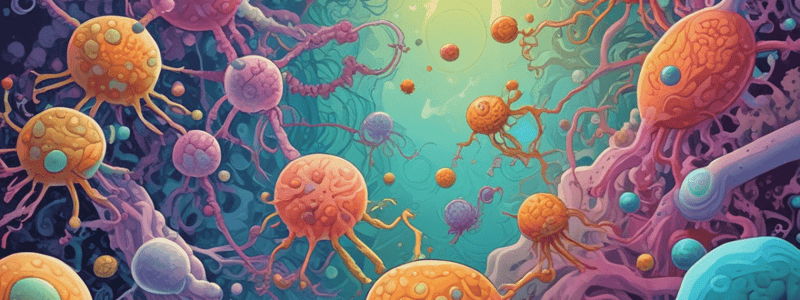Podcast
Questions and Answers
What component is found in both Gram-positive and Gram-negative bacteria?
What component is found in both Gram-positive and Gram-negative bacteria?
- Lipopolysaccharide
- Arabinogalactan polymer
- Mycolic acid
- Peptidoglycan (correct)
Which step in Gram staining differentiates Gram-positive from Gram-negative bacteria?
Which step in Gram staining differentiates Gram-positive from Gram-negative bacteria?
- Decolorization (correct)
- Iodine treatment
- Crystal violet staining
- Fixation
Which of the following is a characteristic of acid-fast bacteria?
Which of the following is a characteristic of acid-fast bacteria?
- Presence of a lipopolysaccharide layer
- Contain teichoic acids in the cell wall
- Undergo Gram staining
- Surrounded by a wax-like lipid coat of mycolic acid (correct)
Which of the following is not a function of a bacterial cell wall?
Which of the following is not a function of a bacterial cell wall?
What role does the cell wall structure play in aiding pathogenicity?
What role does the cell wall structure play in aiding pathogenicity?
What is the function of the mesosome in bacterial cell division?
What is the function of the mesosome in bacterial cell division?
What kind of linkage connects the two sugar derivatives in peptidoglycan?
What kind of linkage connects the two sugar derivatives in peptidoglycan?
Which amino acids are involved in Gram-positive bacteria's peptidoglycan interbridge in S. aureus?
Which amino acids are involved in Gram-positive bacteria's peptidoglycan interbridge in S. aureus?
Which acid is present in the cell wall of Gram-positive bacteria?
Which acid is present in the cell wall of Gram-positive bacteria?
What is the role of D-amino acids in peptidoglycan?
What is the role of D-amino acids in peptidoglycan?
What type of bond in peptidoglycan can be degraded by lysozyme?
What type of bond in peptidoglycan can be degraded by lysozyme?
What is the function of bactoprenol in peptidoglycan synthesis?
What is the function of bactoprenol in peptidoglycan synthesis?
What provides antigenic determinants in Gram-positive bacteria?
What provides antigenic determinants in Gram-positive bacteria?
What feature of M protein of Group A Streptococcus helps protect it from phagocytosis?
What feature of M protein of Group A Streptococcus helps protect it from phagocytosis?
Which enzyme is not found in the periplasmic space?
Which enzyme is not found in the periplasmic space?
What function does the outer membrane of Gram-negative prokaryotes serve?
What function does the outer membrane of Gram-negative prokaryotes serve?
What is the main component leading to the endotoxic activity of LPS?
What is the main component leading to the endotoxic activity of LPS?
Which of the following statements is true about the core polysaccharide of LPS?
Which of the following statements is true about the core polysaccharide of LPS?
What is the main characteristic of the O antigen in LPS?
What is the main characteristic of the O antigen in LPS?
Which of the following is a component of the periplasmic space's chemotaxis system?
Which of the following is a component of the periplasmic space's chemotaxis system?
Which feature is unique to the outer membrane of Gram-negative prokaryotes?
Which feature is unique to the outer membrane of Gram-negative prokaryotes?
Flashcards are hidden until you start studying
Study Notes
Gram-Positive vs. Gram-Negative Bacteria
- Gram-positive bacteria have a thick peptidoglycan layer, a cytoplasmic membrane, and lipopolysaccharide.
- Gram-negative bacteria have a thin peptidoglycan layer, a cytoplasmic membrane, and lipopolysaccharide.
Gram Staining
- Gram-positive bacteria: fixation, crystal violet, iodine treatment, decolorization, and counter stain safranin.
- Gram-negative bacteria: fixation, crystal violet, iodine treatment, decolorization, and counter stain safranin.
Acid-Fast Bacteria
- Mycobacterium has a peptidoglycan layer attached to an arabinogalactan polymer and surrounded by a wax-like lipid coat.
- Acid-fast staining interferes with phagocytosis.
Cell Wall Structure and Function
- The cell wall gives bacteria characteristic shape, protection, transport mechanisms, and aids pathogenicity.
- The cell wall provides advantages to humans, including classification and selective toxicity for anti-microbials.
Proteins
- Proteins form part of the cell wall.
- M protein of Group A Streptococcus protects from phagocytosis and is present as fine processes called fimbriae.
- Protein A of S. aureus binds Fc region of IgG and competes with neutrophil receptors for the Fc region of opsonizing antibodies.
Periplasmic Space
- Enzymes in the periplasmic space include proteases, phosphatases, lipases, nucleases, and carbohydrate degrading enzymes.
- Sugar transport systems and binding proteins are present in the periplasmic space.
- The periplasmic space contains components of the chemotaxis system, sensing the environment outside of the cell.
Outer Membrane
- The outer membrane is composed of lipopolysaccharide (LPS), also known as endotoxin.
- LPS is a powerful stimulator of the immune response, activating B cells, macrophages, and stimulating the release of IL1 and 6, tumor necrosis factor.
- LPS leads to fever, and if present in large amounts, septic shock and multi-organ failure.
Gram-Negative Cell Walls
- Gram-negative cell walls are thinner but more complex than Gram-positive cell walls.
- The cell wall contains a cytoplasmic membrane, a thin layer of peptidoglycan, and a periplasmic space with hydrolytic enzymes.
Outer Membrane
- The outer membrane is unique to Gram-negative prokaryotes and maintains structure and forms a permeability barrier to large molecules.
- The outer membrane provides protection from adverse environmental conditions and has a unique outer edge.
LPS
- LPS has three structural sections: lipid A, core polysaccharide, and O polysaccharide.
- Lipid A is anchored in the membrane and is responsible for endotoxic activity.
- Lipid A is very toxic to the host and is released in large quantities when cells die.
LPS
- The core polysaccharide is branched and contains 9-12 sugars, including the unusual sugar 2 keto-3-deoxy-octanate (KDO).
- The core region is constant for many species of bacteria.
- The O antigen is a long linear polysaccharide that distinguishes serotypes of bacterial species.
Membrane Pores
- Porin protein forms channels in the membrane, allowing transport of larger metabolites.
- The membrane is permeable to hydrophilic molecules, but less so to hydrophobic molecules.
Bacterial Cell Wall Components
- Cytoplasmic membrane contains ion pumps, synthetic enzymes, and a coiled portion called the mesosome.
- The mesosome acts as an anchor to bind and pull apart daughter chromosomes during cell division.
Peptidoglycan
- Peptidoglycan is cross-linked with a tetrapeptide and is characteristic for each specific bacterium.
- In Gram-positive bacteria, cross-linking involves a peptide interbridge.
- In S. aureus, each interbridge peptide consists of 5 molecules of the amino acid glycine connected by peptide bonds.
Peptidoglycan: Diversity
- Tetrapeptide contains both D and L amino acids.
- The first two amino acids may vary for different organisms.
- The third amino acid is essential for cross-linking.
- D-amino amino acids include lysine and diaminopimelic acid (DAP).
Additional Components
- In Gram-positive bacteria, peptidoglycan forms multiple layers and is often cross-linked in 3 dimensions.
- Teichoic acid is present in the wall and is an acidic polysaccharide that contains glycerophosphate or ribitol phosphate residues.
Peptidoglycan (Murein)
- Peptidoglycan is common to all types of bacterial cell walls.
- It is composed of a basic structure of two sugar derivatives connected in β1-4 linkages.
- The glycan chains are connected by peptide cross-links of four amino acids to give rigidity.
Peptidoglycan Specifics
- Peptidoglycan forms a mesh-like exoskeleton but is porous enough to allow diffusion of metabolites.
- It is essential for survival in hostile conditions.
- Peptidoglycan can interfere with phagocytosis, is mitogenic for lymphocytes, and has pyrogenic activity.
- The β1-4 bond can be degraded by lysozyme.
Peptidoglycan
- Precursor form of the peptide has an extra D-ala, which is released during the cross-linking step.
- Prefabricated subunits are assembled on the inside of the cell and brought to the surface by a large phospholipid called bactoprenol.
Teichoic Acid and Lipoteichoic Acid
- Glycerol-containing acids are bound to membrane lipids of Gram-positives and are called lipoteichoic acids.
- They mediate attachment to host cells and provide antigenic determinants.
- Sugars, choline, or D-alanine may be attached to the hydroxyls of the ribose or glycerol, determining serotype.
Studying That Suits You
Use AI to generate personalized quizzes and flashcards to suit your learning preferences.




